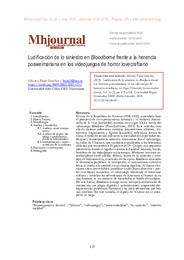Resumen :
El cine de la República de Weimar (1918-1933), entendido bajo el parapeto de su expresionismo tortuoso y el realismo descar-nado de la Neue Sachlichkeit, resucita en el siglo XXI a través del videojuego Bloodborne (FromSoftware, 2015). Este artículo, más allá de rastrear influencias estéticas (arquitecturas oblicuas, cla-roscuros angustiantes y figuras liminales), reflexiona acerca de cómo el título de acción subvierte la pasividad del espectador tra-dicional y reinterpreta la narrativa weimariana. En el videojuego, las calles de Yharnam, que mantienen similitudes a los laberintos oblicuos que recuerdan a El gabinete del Dr. Caligari, son prisiones interactivas donde el jugador encarna la dualidad humana/bestia, heredera de los doppelgängers monstruosos. Mediante un cruce in-terdisciplinar entre análisis fílmico, teoría de lo siniestro y estu-dios de ludonarrativa, el artículo revela cómo Bloodborne convierte la alienación posbélica, la corrupción, el inconsciente colectivo hacia el miedo a la otredad en mecánicas jugables. Al forzar elec-ciones éticas irreversibles (sacrificar civiles para sobrevivir y pac-tar con dioses amorales), el videojuego trasciende el homenaje estético y actualiza las advertencias de Kracauer: el horror no es una fantasía, es un síntoma de sociedades al borde del colapso. De esta forma, Bloodborne emerge como un espejo deformante de nuestra era: sus plagas digitales y polarizaciones sangrientas dia-logan con las pandemias históricas y las crisis identitarias que hoy nos acechan. En este sentido, el legado de Weimar no se inter-preta: se juega
Cinema of the Weimar Republic (1918–1933), understood through the prism of its tormented Expressionism and the raw realism of Neue Sachlichkeit, is resurrected in the 21st century through the videogame Bloodborne (FromSoftware, 2015). Beyond tracing aesthetic influences (oblique architecture, distressing chi-aroscuro, and liminal figures), this article reflects on how this ac-tion title subverts the passivity of the traditional spectator and reinterprets Weimarian narrative. In the videogame, the streets of Yharnam—which resemble the oblique labyrinths recalling The Cabinet of Dr. Caligari—are interactive prisons where play-ers embody the human/beast duality inherited from monstrous doppelgängers. Through an interdisciplinary approach combin-ing film analysis, theories of the uncanny, and ludonarrative stud-ies, this article reveals how Bloodborne translates post-war aliena-tion, corruption, and the collective unconscious fear of otherness into gameplay mechanics. By forcing irreversible ethical choices (sacrificing civilians for survival and bargaining with amoral gods), the videogame transcends mere aesthetic homage and up-dates Kracauer’s warnings: horror is not fantasy; it is sympto-matic of societies on the brink of collapse. Thus, Bloodborneemerges as a distorted mirror of our era, its digital plagues and bloody polarizations echoing historical pandemics and contem-porary identity crises. In this sense, Weimar’s legacy is not re-peated—it is played
|

 La licencia se describe como: Atribución-NonComercial-NoDerivada 4.0 Internacional.
La licencia se describe como: Atribución-NonComercial-NoDerivada 4.0 Internacional.
.png)